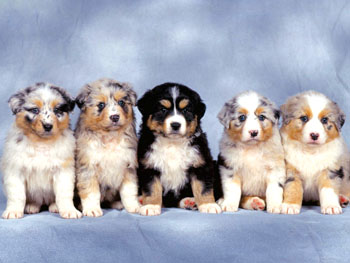
You donât have to own a pet to be fond of one
 ANIMAL lovers often find themselves in circumstances that are less
than ideal for owning pets. Travelling or changing residencies often,
working long hours, living in a very small apartment or a building that
doesnât allow animals, having housemates or family members that are
allergic to certain animals, or a lack of funds can all make pet owning
stressful rather than enjoyable for both the pet and the person. ANIMAL lovers often find themselves in circumstances that are less
than ideal for owning pets. Travelling or changing residencies often,
working long hours, living in a very small apartment or a building that
doesnât allow animals, having housemates or family members that are
allergic to certain animals, or a lack of funds can all make pet owning
stressful rather than enjoyable for both the pet and the person.
Although you may not have any pets at home, there are many secrets to
vicarious pet ownership.
You may be able to receive regular doses of fuzzy affection by being
âauntâ to many animals, and this is only one of many ways for animal
lovers to enjoy the friendship of an animal without committing to pet
ownership.
If you have a relative, friend, or neighbour who is thinking of
adopting a pet, you can tag along to choose the pet and share in the
excitement of shopping for all the essentials - the bowls, the bed, the
first bag of food, the squeaky toys. If youâre lucky, you may get the
title âauntâ or âuncleâ bestowed upon you.
As an aunt or uncle of an animal, you get the honour of the ownerâs
trust with their beloved pet, and you develop a long-term relationship
with the animal. You will likely be called upon for regular pet sitting,
and you can offer to walk or care for the animal when the owner is sick
or gets stuck late at work.
 Having a âniece- or nephew-petâ also gives you a reason to browse the
local pet store to buy little gifts and, like having a human niece or
nephew, you have the benefit of being the good guy, leaving most issues
of training and discipline to its owners. Having a âniece- or nephew-petâ also gives you a reason to browse the
local pet store to buy little gifts and, like having a human niece or
nephew, you have the benefit of being the good guy, leaving most issues
of training and discipline to its owners.
If you are in a situation that allows you to make a temporary
commitment to a pet, fostering may be an option. Many organisations need
foster caregivers for cats and dogs while they await permanent adoption.
If you just need a small dose of cold noses, volunteering at a local
animal shelter can give you some hands-on time with animals. Sometimes
pet store chains need volunteers to handle animals for special adoption
days.
Organisations unique to your community may have unique volunteer
opportunities available.
For example, veterinary clinics may allow volunteers to spend time
lending a hand if many of the petsâ owners live hours from the hospital,
the pet may have to stay for several days of treatment without seeing
their owner, so hospital volunteers keep the patients from getting
lonely, playing with and petting them.
For horse lovers, some stables may need volunteers to help groom,
tack, and handle horses for non-profit events or activities such as
hippotherapy programs that utilize horses for physical or mental
therapy.
So, fellow animal lover, if you do not and cannot own a pet right
now, you donât have to resort to wandering around the local dog park,
trying to blend in while sneaking pats-on-the-head and occasional hugs
from other peopleâs dogs; you may be needed as a vicarious pet owner,
dog-sitter, pet walker, aunt or uncle, foster caregiver, or volunteer.
Flower of the week: Zinnias - If you grow them butterflies will come
 Zinnias will reward you with bundles of colorful blooms in the summer
provided that you give them rich, loamy soil in a sunny place. Donât
over-water! Zinnias like hot, dry weather. Zinnias will reward you with bundles of colorful blooms in the summer
provided that you give them rich, loamy soil in a sunny place. Donât
over-water! Zinnias like hot, dry weather.
Cut them frequently to encourage branching and to prolong blooming.
Resist the urge to line plants up singly as an edging; zinnias are more
appealing as an irregular mass of bright colours.
The flowers have a range of appearances, from a single row of petals,
to a dome shape, with the colours white, chartreuse, yellow, orange,
red, purple and lilac.
Be aware that zinnias dislike root disturbance. Harden them off
gradually by setting flats outdoors for a few hours each day.
Transplant carefully after weather is reliably warm, trying not to
expose the roots. Water seedlings upon planting but infrequently during
summer. When growth resumes, give them a light application of
fertilizer.
The hairy leaves of zinnias are prone to powdery mildew in humid
areas and during late summer and fall, when dew is heavy.
Space plants to give them adequate air circulation and avoid overhead
watering, which spreads the mildew spores. No one will notice if you
have removed infected leaves before filling a vase with an assortment of
festive zinnias.
Zinnias excel as cut flowers; their rigid stems hold long-lasting
blossoms that donât drop petals. They are especially favoured by
butterflies, and many gardeners add zinnias specifically to attract
them.
Grab a camera: 12 tips to take better garden pictures
 *Shoot early in the morning. Follow this tip and you will take better
garden pictures all season long, guaranteed. The light is softer early
in the day, and flowers and leaves often have dew or raindrops that can
add interest, especially for close-ups. *Shoot early in the morning. Follow this tip and you will take better
garden pictures all season long, guaranteed. The light is softer early
in the day, and flowers and leaves often have dew or raindrops that can
add interest, especially for close-ups.
*Mornings are also ideal for low wind. There is often no breeze or
wind early in the day, which cuts down on motion-blur to keep your
flower and garden scenes sharp.
*Bright, sunny afternoons are the worst time to take pictures. Thatâs
because the sun casts contrasty shadows that look black, and the harsh
light washes out flower colours. However, another good time for pictures
is in early evening when the light becomes soft and warm again.
*Calm, overcast days also let you take better garden pictures. On
such days, the bright white sky acts as a huge reflector, intensifying
leaf and flower colours. Just be sure to compose your pictures, so that
you crop out sweeps of white sky.
*White sky can confound your cameraâs light meter. This can make the
subject of your picture look too dark. If you leave the sky out of your
composition, you will avoid this problem.
*Use a tripod. Itâs difficult to keep a camera completely steady
without a tripod. Hand-held photographs, especially those taken in lower
light conditions often suffer from âcamera shake.â The result: blurry
pictures from camera movement.
*A tripod makes a great tool for better composition. Even with
cameras and lenses that have âanti-shakeâ technology, using a tripod
forces you to slow down and take more time to compose and frame your
pictures.
*Weed and groom your garden before taking pictures. Things your eye
skips over in real time - dry twigs or faded flowers, or a hose left on
the grass - are very distracting in a photo, so look carefully before
you press the shutter.
*Fill the frame with your subject. Get in close for a great picture
of your perfect peony, and keep your background as uncluttered as
possible. Donât put flowers smack-dab in the middle of the photo. If
your subject is in shade, avoid bright backgrounds.
*Focus on what it is that drew you to take that particular picture.
Most people try to get too much into a single photo. Emphasize your
subject and crop unnecessary details out. Keep asking yourself: What is
this picture really about?
*For a fresh take on your garden, try different view points. We all
get used to seeing our own gardens from particular places. To break out
of the predictable, get down low to photograph low-growing plants, or
take a stepladder or shoot from an upstairs window to look down a garden
bed. Try photographing from behind or even in a flowerbed.
*To take better garden pictures, use lines in the landscape to
suggest depth. Cameras turn three-dimensional subjects into flat
two-dimensional photos. A common pro trick to add depth is to use lines
in a scene on a diagonal.
Take better garden pictures for planning:
*Take lots of photos through the season. This is easier than ever
with digital as you donât have to worry about the cost of film and
developing.
Go out every two to three weeks. Then use the photos to keep a record
of what you like - such as great plant combinations - or to assess areas
that need improvement.
*A panoramic view is useful for visualizing change. Stand in one spot
and take two or three different garden photos, making sure each frame
overlaps the previous one slightly.
* Then you can tape your prints together for a complete overview of
the garden.
* Even better, with a photo-editing program on your computer, you can
âstitchâ digital pictures together to create a single image.
* Blow this picture up, print it, and cover it with see-through
tracing paper.
You can draw on the tracing paper to help you visualize landscaping
changes, such as what your garden will look like when young trees have
grown taller. |

